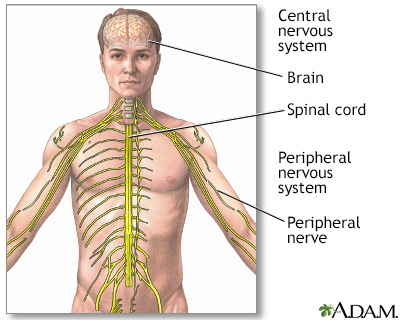Autonomic dysreflexia
Autonomic hyperreflexia; Spinal cord injury - autonomic dysreflexia; SCI - autonomic dysreflexia; Sympathetic hyperreflexia
Autonomic dysreflexia (AD) is an abnormal, overreaction of the involuntary (autonomic) nervous system to stimulation. This reaction may include:
- Change in heart rate
- Excessive sweating
- High blood pressure
- Muscle spasms
- Skin color changes (paleness, redness, blue-gray skin color)

The central nervous system comprises the brain and spinal cord. The peripheral nervous system includes all peripheral nerves.
Causes
The cause of AD is spinal cord injury, most often due to spine trauma. The nervous system of people with AD over-responds to the types of stimulation that do not bother healthy people.
Other conditions may cause autonomic dysfunction (not dysreflexia) which has similar symptoms, including:
- Guillain-Barré syndrome (disorder in which the body's immune system mistakenly attacks part of the nervous system)
- Side effects of some medicines
- Severe head trauma and other brain injuries
- Subarachnoid hemorrhage (a form of brain bleeding)
- Use of illegal stimulant drugs such as cocaine and amphetamines
Symptoms
Symptoms can include any of the following:
- Anxiety or worry
- Bladder or bowel problems
- Blurry vision, widened (dilated) pupils
- Lightheadedness, dizziness, or fainting
- Fever
- Goosebumps, flushed (red) skin above the level of the spinal cord injury
- Heavy sweating
- High blood pressure
- Irregular heartbeat, slow or fast pulse
- Muscle spasms, especially in the jaw
- Nasal congestion
- Throbbing headache
Sometimes there are no symptoms, even with a dangerous rise in blood pressure.
Exams and Tests
Your health care provider will do a complete nervous system and medical exam. Tell your provider about all the medicines you are taking now and that you took in the past. This helps determine which tests you need.
Tests may include:
- Blood and urine tests
- CT or MRI scan
- ECG (measurement of the heart's electrical activity)
- Lumbar puncture
- Tilt-table testing (testing of blood pressure as the body position changes)
- Toxicology screening (tests for any medicines, including illegal drugs, in your bloodstream)
- X-rays
Other conditions share many symptoms with AD, but have a different cause. The exam and testing help your provider rule out these other conditions, including:
- Carcinoid syndrome (tumors of the small intestine, colon, appendix, and bronchial tubes in the lungs)
- Neuroleptic malignant syndrome (a condition caused by some medicines that leads to muscle stiffness, high fever, and drowsiness)
- Pheochromocytoma (tumor of the adrenal gland)
- Serotonin syndrome (reaction to a medicine that causes the body to have too much serotonin, a chemical produced by nerve cells)
- Thyroid storm (life-threatening condition from an overactive thyroid)
Treatment
AD is life threatening, so it is important to quickly find and treat the problem.
A person with symptoms of AD should:
- Sit up and raise their head
- Remove tight clothing
Proper treatment depends on the cause. If medicines or illegal drugs are worsening the symptoms, they must be stopped. Any illness needs to be treated. For example, the provider will check for a blocked urinary catheter and signs of constipation which may cause AD in someone with a spinal cord injury. The person should be checked for injuries, sores, or other irritants that may be triggering the symptoms.
If a slowing of the heart rate is causing AD, medicines called anticholinergics (such as atropine) may be used.
Very high blood pressure needs to be treated quickly but carefully, because the blood pressure can drop suddenly.
A pacemaker may be needed for an unstable heart rhythm.
Outlook (Prognosis)
Outlook depends on the cause.
People with autonomic dysfunction due to a medicine usually recover when that medicine is stopped. When AD is aggravated by other factors, recovery depends on how well the disease can be treated.
Possible Complications
Complications may occur due to side effects of medicines used to treat the condition. A sudden severe increase in blood pressure can cause a stroke or bleeding into the brain. Long-term, severe high blood pressure may cause seizures, bleeding in the eyes, stroke, or death.
When to Contact a Medical Professional
Contact your provider right away if you have symptoms of AD.
Prevention
In people with spinal cord injury, the following may help lessen AD symptoms:
- Avoid medicines that make AD symptoms worse
- Do not let the bladder become too full
- Pain should be controlled
- Practice proper bowel care to avoid stool impaction
- Practice proper skin care to avoid bedsores and skin infections
- Prevent bladder infections
References
Benarroch EE, Freeman R. Autonomic disorders. In: Goldman L, Cooney KA, eds. Goldman-Cecil Medicine. 27th ed. Philadelphia, PA: Elsevier; 2024:chap 386.
Khanna R, Fessler RD, Snyder L, Fessler RG. Spinal cord trauma. In: Jankovic J, Mazziotta JC, Pomeroy SL, Newman NJ, eds. Bradley and Daroff's Neurology in Clinical Practice. 8th ed. Philadelphia, PA: Elsevier; 2022:chap 63.
McDonagh DL, Barden CB. Autonomic dysreflexia. In: Fleisher LA, Rosenbaum SH, eds. Complications in Anesthesia. 3rd ed. Philadelphia, PA: Elsevier; 2018:chap 131.
Version Info
Last reviewed on: 6/13/2024
Reviewed by: Joseph V. Campellone, MD, Department of Neurology, Cooper Medical School at Rowan University, Camden, NJ. Review provided by VeriMed Healthcare Network. Also reviewed by David C. Dugdale, MD, Medical Director, Brenda Conaway, Editorial Director, and the A.D.A.M. Editorial team.
